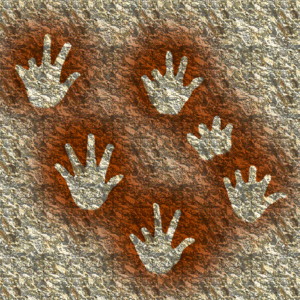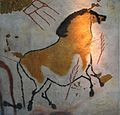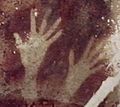Cave painting facts for kids
Cave paintings are amazing drawings and paintings found on the walls and ceilings inside caves. Most of these artworks were made a very long time ago, during prehistoric times. Many of the most famous cave paintings are between 10,000 and 20,000 years old. Some scientists even think the oldest ones could be around 32,000 years old!
We don't know for sure why people made these paintings. Many experts believe they were part of rituals or special ceremonies. They might also have been a way to share important information, like telling stories or showing others about something. Interestingly, most of these paintings are in parts of caves that are hard to reach. These areas usually don't show signs that people lived there all the time.
Today, we know about 350 caves around the world that have these ancient paintings. Many of them are in France and Spain. Some of the most famous caves include Altamira in Spain, Lascaux in France, and Creswell Crags in England. Sometimes, paintings were also made on outdoor cliff faces. However, fewer of these have survived because of erosion from weather. An example of outdoor rock art is found at Astuvansalmi in Finland.
Most often, the paintings show animals or scenes of hunting. You can also sometimes see drawings of hands. It's rare to find more abstract patterns or symbols.
The artists used natural materials to create their colors. They drew with red and yellow ochre, a type of natural earth pigment. They also used hematite, manganese oxide, and charcoal (burnt wood). Sometimes, they would first carve the outline, or silhouette, of an animal into the rock before painting it.
Contents
Why Did People Paint in Caves?
There are many ideas about why prehistoric people painted in caves. Here are some of the most common explanations:
Hunting Magic or Shamanism
One idea is that the paintings were a form of "hunting magic." People might have believed that drawing animals would help them have more animals to hunt, or make their hunts more successful. Another similar idea comes from studying hunter-gatherer societies. This theory suggests that shamans, who were spiritual leaders, made these paintings. A shaman might go deep into a dark cave, enter a special trance state, and then paint what they saw in their visions. They might have thought they were drawing power from the cave walls themselves.
Ancient Graffiti
Another theory suggests that some of the paintings might have been a type of graffiti. This idea proposes that many of these drawings were made by young people, especially teenage boys. At the same time, small statues called Venus figurines were also made. This theory suggests there were many young people in society back then. While most of the artists might have been male, some could have been female.
Practical Reasons
Some experts think the paintings had practical purposes. They might have contained hidden messages or symbols. These symbols could have shown hunting techniques, or even the paths that animals took during their migrations.
Art for Art's Sake
Finally, some people believe that these paintings were simply "art" for the people of that time. They might have painted what they wished for, or what they had dreamt about. It's important to remember that some societies today don't have a specific word for "art," but they still create beautiful paintings, just like our ancestors did.
Gallery
Related pages
Images for kids
-
Cueva de las Manos, Perito Moreno, Argentina. The art in the cave is dated between 7,300 BC and 700 AD, stenciled, mostly left hands are shown.
-
One of the oldest known figurative paintings, a depiction of an unknown bovine, was discovered in the Lubang Jeriji Saléh cave and dated to be more than 40,000 (perhaps as old as 52,000) years old.
-
An artistic depiction of a group of rhinoceros was completed in the Chauvet Cave 30,000 to 32,000 years ago.
-
Prehistoric cave painting of animals at Albarracín, Teruel, Spain (rock art of the Iberian Mediterranean Basin)
-
30,000-year-old cave hyena painting found in the Chauvet Cave, France
-
Polychrome cave painting of a wolf, Font-de-Gaume, France
-
Bhimbetka rock painting
-
Dera Rock Art in, Eritrea
-
Rock art in the Adi Alauti cave, Eritrea
-
Cave paintings at the Laas Geel complex in northern Somaliland.
-
Cave painting at the Tassili n'Ajjer UNESCO World Heritage Site in southeast Algeria.
-
San rock paintings from the Western Cape in South Africa.
-
Painted Cave, Santa Barbara County, California
-
Cave painting at Serra da Capivara National Park, Brazil
See also
 In Spanish: Pintura rupestre en cuevas para niños
In Spanish: Pintura rupestre en cuevas para niños


























